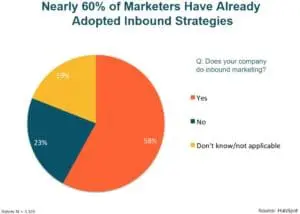 I’ve recently spoken with marketing directors at several companies that were excited about the power of inbound marketing, but were having a problem selling company management on the idea of inbound marketing. I suggested they build a case for the value of inbound marketing and apply a “stealth approach” by mixing a little inbound marketing into their current marketing efforts. This would be a powerful demonstration of the value of inbound marketing for your company/customers.
I’ve recently spoken with marketing directors at several companies that were excited about the power of inbound marketing, but were having a problem selling company management on the idea of inbound marketing. I suggested they build a case for the value of inbound marketing and apply a “stealth approach” by mixing a little inbound marketing into their current marketing efforts. This would be a powerful demonstration of the value of inbound marketing for your company/customers.
If your boss is not yet convinced of the value of inbound marketing for your company, read on!
Build the case for inbound marketing
Since your goal is to sell your boss on the value of inbound marketing, you should approach it the same way you would go about selling to an outside customer. What is important to your boss? How much does he or she already know, and what additional information will be needed to make a decision? What personal or company benefits will inbound marketing provide?
You can then tailor your message.
- Does your boss take pride in being the best? Content marketing allows a person to show off his or her expertise.
- Is your boss focused on numbers, efficiency and constant improvement? Inbound marketing allows you to accurately track ROI, and marketing automation software helps you optimize your marketing efforts.
- Is keeping up with competitors a concern? Demonstrate how your competitors are succeeding with inbound marketing.
- Is your superior simply not tech-savvy? Explain that social media is just today’s medium for word-of-mouth customer referrals, and today’s search engines are a more convenient replacement for yesterday’s yellow pages.
Show the value of inbound marketing by sharing the ROI other companies are achieving
 Because inbound marketing can be directly tracked online, it finally gives you the ability to prove the ROI of your marketing campaigns. And one benefit of inbound marketing is that the return on your investment builds over time. An outbound ad campaign only produces results as long as you continue to pay for more ads. Social media networking and inbound content marketing build on themselves over time, providing long-term returns on the initial investment.
Because inbound marketing can be directly tracked online, it finally gives you the ability to prove the ROI of your marketing campaigns. And one benefit of inbound marketing is that the return on your investment builds over time. An outbound ad campaign only produces results as long as you continue to pay for more ads. Social media networking and inbound content marketing build on themselves over time, providing long-term returns on the initial investment.
However, that also means you cannot demonstrate your own inbound marketing ROI until you have put forth the investment to build the program. To demonstrate its value to your boss, you should use the proven results of those who already use inbound marketing.
- Companies that focus on inbound marketing have a 61% lower average cost per lead than companies that focus on outbound marketing.
- Just having a website isn’t enough; companies that create content and blog regularly produce 70 percent more leads than those who don’t.
- Leads from inbound marketing are roughly 7x more likely to close than outbound marketing leads.
- Other companies do see the value in the investment, as overall inbound marketing budgets have been steadily increasing each year while outbound marketing budgets are decreasing.
How to start with inbound marketing in stealth mode
We all know that change is hard, and no good executive wants to make a big change to the way their marketing group works. Of course, they’d like to increase the RESULTS that marketing produces in terms of number of leads, but they’re not quite ready to made a big change.
That means if you’re really interested in transitioning your company to inbound marketing, it’s time to take a stealth approach and integrate inbound marketing with your company’s existing marketing campaigns.
Over time, you can not only prove the value of inbound marketing as your campaigns start to generate a strong ROI, but you’ll already have that gradual transition to inbound marketing methods underway!
Here’s a roadmap for your stealth approach to inbound marketing for technology companies.
Merge inbound tactics with outbound campaigns
Many marketers have already started to integrate inbound and traditional marketing. According to Marketing Charts, 90% of marketers believe using online data to optimize the offline experience is important. Furthermore, 73% of company marketers say they will be using a cross-channel marketing strategy over the next few years.
Clearly a large population of marketers are comfortable with weaving online marketing tactics with their traditional campaigns. So let’s start there, with a few examples.
Connect your print marketing with a social media campaign
Your company already uses print to advertise, so consider adding a Twitter campaign to the mix. Make sure your Twitter presence is congruent with your print messaging, and then add your Twitter address to the print collateral. Now you can add regular content to Twitter to keep your new following engaged. Ask questions and develop dialogues. Share the “day-in-the-life” kinds of things that people want to hear about — what’s it like to use your product or service?
Attach a landing page to your print ads and direct mail
 Your print advertisements may get you noticed, but it’s the call-to-action part that’s difficult. In other words, is there any way to get someone to actually take action when they’re inspired by your print ads? Well, when your team sits down to put together their next print ad, ask them for a little space for some copy that points readers to an online destination. This could be through a QR code, or by simply including a URL to a landing page on your website.
Your print advertisements may get you noticed, but it’s the call-to-action part that’s difficult. In other words, is there any way to get someone to actually take action when they’re inspired by your print ads? Well, when your team sits down to put together their next print ad, ask them for a little space for some copy that points readers to an online destination. This could be through a QR code, or by simply including a URL to a landing page on your website.
Ideally, the landing page will have no site navigation that can distract a visitor from the one thing you want her to do: fill out the form to get your offer. Follow these tips for a winning landing page.
Simultaneously run inbound campaign alongside more traditional campaigns
Now that you’ve started to integrate digital and print campaigns, think about how you can run a few additional campaigns of your own. Make this easier by promising you’ll still complete your routine tasks — these additional campaigns will be tests you’re running in addition to those. While this will require more of your time for a bit, it won’t require more of your budget, making it easier to sell your boss and colleagues on the subject. Here are some quick campaigns you can run to include in your ultimate portfolio for convincing your team.
Re-purpose existing content to create some lead generation offers
You have content all over the place and may not even realize it! Gather together the pamphlets, brochures, blog posts, training manuals, newspaper articles, case studies, testimonials — whatever you can find — and start reworking some of this content into an offer you can put behind a form, or share across social media.
Setup calls-to-action and landing pages
See if your manager would be OK with you making some website tweaks. You’re not going to redesign the skin or anything, but you could improve on what’s already there. . . and make some key changes.
Create a call-to-action (CTA) right on the home page. It’s easy, and you can even make CTAs in PowerPoint. The CTA should lead to a new landing page that houses one of the awesome new offers you just created. Make sure you consider what type of offer a visitor to your home page might be interested in. When the rest of your team sees people taking advantage of your offer and identifying themselves, they will get pretty interested in this “inbound marketing thing.”
Create visual social media content
 Put on your creative hat and think of a cool new idea for increasing engagement on your social media channels. Can you create a series of memes around a common industry fad? Can you create a few visual representations of important stats and data in your field? You don’t need Photoshop to do this, either. Just head over to memegenerator.net or use PowerPoint or Google Slides to whip up some visuals that can be easily shared, helping you generate more fans and followers and increase your overall social reach.
Put on your creative hat and think of a cool new idea for increasing engagement on your social media channels. Can you create a series of memes around a common industry fad? Can you create a few visual representations of important stats and data in your field? You don’t need Photoshop to do this, either. Just head over to memegenerator.net or use PowerPoint or Google Slides to whip up some visuals that can be easily shared, helping you generate more fans and followers and increase your overall social reach.
Create and share your blog content
Start writing posts on your company blog – and if you don’t have one, set one up! But be strategic. You can’t just write a post and hope the world stumbles upon it. Instead, start sharing that post with advocates of your brand or others who would find it valuable. And yes, that includes your social media fans and followers. You also need to make sure search engines can find it by writing about topics germane to your company and industry. It would also help to start writing guest blog posts for other related sites so you can get some of those coveted inbound links that help your site rise in the search engine rankings!
Collect and compare metrics
Now that you’ve got some campaigns up and running, you can start collecting metrics that speak to their effectiveness. Collect every metric humanly possible. Generate reports that show you the number of retweets you’re getting. Watch for increased traffic to your website. Look at your website analytics to see how many users went to your customized landing pages or landed on your website because of your blog posts, or from Twitter. See which keywords drove the most traffic to your website. You now can see what didn’t work, what did work, and what really, really worked. These metrics will show impact you can tie directly to business goals like generating revenue and closing new business.
Organize all your inbound marketing results into a clear, succinct, and educational presentation so you can prove the ROI of inbound marketing to your management team. And when you use data based off of recent campaigns — data that you can tie directly to leads and customers generated — you don’t have that difficult of a case to make!





